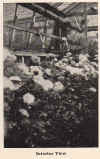|


| |
Monroe Greenhouse
From the March 1928 issue of "Great Northern Semaphore"
The Park Department Speaks Up
 
Click Here
for an additional story about the Monroe Greenhouse.
This seems an appropriate time to commence a series of
articles on the Park Department of the Great Northern,
as February 1 is the third anniversary of that branch
of the railroad work. These articles will appear as
space permits and will be prepared for the SEMAPHORE
by Mrs. Florence M. Ditmeyer of the office of the
supervisor of parks.
The work of George W. Dishmaker, while he was agent at
Elk, Washington, became known all over our System and
elsewhere. It was his beautification of the station
grounds there, which proved to be the seed from which
our present organization grew.
During the year 1925, the plants for station grounds
were grown in a little hothouse at Elk, but as the work
was extended, more adequate quarters became necessary.
It was then that Mr. Dishmaker, who had been appointed
supervisor of parks, made a comprehensive study of the
various districts along the Great Northern lines, searching
for the location best adapted to our needs. The result
was the greenhouse at Monroe, Washington, and the building
there was completed in 1926. The climate at Monroe is
particularly good for this business, as the growing season
is long. Best dahlias were being cut last year in
November, and the blossoms were still good during the
early part of December.
On what is termed the "Gladiola Farm," located around the
section house on the Cherry Valley line, about three
blocks from the tracks, are raised the Glads for use
on our diners. During 1927, more than 85,000 large bulbs
of many varieties were planted and about 20,000 small
bulb-lets. During the heavy cutting season in July and
August, the daily cut averaged about 2,000 stems. These
are cut in the morning, requiring the time of one man for
about two or three hours. They are then brought to the
service house, where they are stripped of all loose leaves,
tied in bundles of twenty-five and put in water in the
cool basement until nearly train time. They are shipped
in three and four foot, specially-constructed boxes of
wood, holding one and two hundred respectively.
The dahlias and sweet peas are also grown at the farm and
it is interesting to know that during the tourist season
last year, each lady traveling on the Pullman cars on
our lines, was presented with a corsage bouquet of sweet
peas and ferns. The daily cut averaged about five
thousand stems, each bearing a fragrant message of the
Great Northern's better and more distinctive service
to its guests.
As the gladiolus pass, the Michaelmas daisies, helenium
and dahlias come on to take their place. Combined with
the red foliage of the vining maple tree, these flowers
seem to have been especially attractive to travelers
from the East.
November sees our stock of field grown flowers getting
somewhat scant, but at this time the "mums" are ready
and for real Autumn glory there is nothing more
beautiful. The pink and white Dotys and the bronze,
yellows, dull reds and rose of the pom-pom variety give
an endless selection in color combination. The large
standard mums are used in baskets on the observation
cars and for special bouquets. This season we combined
them with plumosa and the native salal with unusual
and charming results.
December finds the carnations coming on well, and the
mum benches are cleaned out and only stock plants for
the next year are saved. A survey of the work of the
past year, discloses that over 275,000 cut flowers of
various kinds from the field and hot houses, have been
cut, stripped, bunched and shipped.
December also brings more than the carnations, for in the
greenhouse there can be no minute shopping. The first of
the month finds every one on his toes and strongly imbued
with the Christmas spirit. In 1927 we put out twelve
hundred and fifty feet of cedar roping and seven hundred
wreaths of holly and cedar and holly combined. We used
twelve large cases of eastern holly and four truck loads
of cedar boughs, ten pounds of ruscus, fifteen pounds of
fine wire and seven hundred and twenty yards of red satin
ribbon for the wreaths. This work was done by the regular
greenhouse force and the reader may imagine that everybody
worked! In 1926, when we used a different style of
decorating, we made fewer wreathes but nearly one mile of
cedar roping. The large Christmas trees in the depots at
Seattle, Spokane, Minneapolis and other of the larger places
on both the east and west ends, were also cut and shipped
by the park department. These trees were from fifteen
feet to thirty feet in height.
With Christmas over, work in the greenhouses goes on apace,
for this is the beginning of our busiest season. Thousands
of plants to be repotted and seeds sown for the necessary
bedding plants for use over the system. In 1927 over
100,000 bedding plants were raised in the greenhouse. Of
this number over 20,000 were used in making up three
hundred and forty hanging baskets, fifty-two tubs, and six
hundred and twenty lineal feet of window boxes for station
decoration. The remainder of the plants were used in flower
gardens on the System. In the hothouse, the Easter lilies
are up about four inches when this is being written and
one wonders "can Spring be far behind."
The End
Click Here
for an additional story about the Monroe Greenhouse.
  |